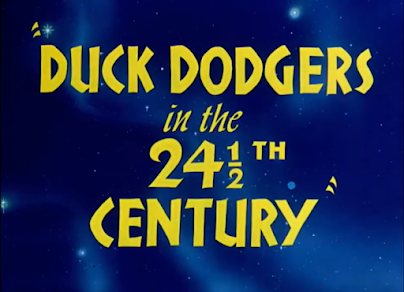Cartoon animals and other people
In the classic cartoons of the Warner Brothers studio, characters who fill a "human-type" role can be either humans, or humanoid animals. The directors and story artists would need to decide which the character was going to be, and I have to wonder how often it was a conscious decision, and how often it was instinctive.
Sometimes an anthro animal's species is important, and sometimes it isn't. Friz Freleng's Curtain Razor (1949) has a mix. It's more or less a spot-gag cartoon about performers, anchored by Porky Pig (an example of an anthro animal whose species is usually unimportant) as a talent agent.
Other characters whose species are unimportant are the impressionist turtle, the high-diving dog, and the birds who are caricatures of popular singers (except for a vague bird/song connection, and the fact that earlier cartoons had featured a Bing Crosby parrot and a Frank Sinatra rooster).
The cartoon also has:
1) A grasshopper with a loud operatic voice - the contrast appears to be the gag so it's important that he's a very small creature.
2) A hen who clucks the Blue Danube Waltz, then "lays an egg" (a Literal Metaphor for the theatrical/critical term for an unsuccessful performance). It's necessary that she's from an egg-laying species, and I guess the Blue Danube Waltz sounds amusing in a chicken's clucks.
3) A dog who carries a flea circus around with him. Now, fleas will leap onto lots of animals, but they are most commonly associated with dogs. In fact, this dog isn't even anthropomorphic, although he does have human capabilities that dogs in our world don't have [citation needed]. Curiously, when Porky sees him he exclaims "Oh, a dog act!" as if it's a novelty. I guess he must have forgotten about the high-diver, or he makes a distinction based on whether a dog walks on two legs or on four.
There are only two humans in the cartoon:
The two-headed janitor, and Crawford Coo. In the case of the janitor, maybe Friz and his team wanted to make the two heads the only noteworthy thing about him (to Porky and to the audience), so making him *also* an anthro animal would be too much.
Crawford Coo has a troupe of "trained" pigeons, and the main gag is that the pigeons (who are realistically drawn) don't actually perform but act like normal pigeons and fly out the nearest window. The contrast between human and animal might have been deemed necessary for the gag to work, although Friz later reused it in Show Biz Bugs (1957), where Daffy Duck (an anthro animal whose species is *often* important) had the troupe of pigeons.
Incidentally, I love the way that Crawford, upon seeing that his pigeon show has failed, hastily improvises a tap-dance as a fall-back. This gag *wasn't* re-used in Show Biz Bugs, possibly because the cartoon had already featured a dance-off between Bugs and Daffy and it would have been redundant.
The grand finale:
The cartoon ends with an enthusiastic fox, who dresses himself in a devil costume and spectacularly blows himself up. (He returns as a ghost, apologising that he "can only do it once") It isn't necessary to the gag that he's a fox, but they may have felt that he had to be *some* kind of animal, as seeing a human performing the act would have been too gruesome. This gag was also used, complete with with ghost ending, as the finale of Show Biz Bugs, where again it's Daffy who performs it. (Is it funnier to watch a familiar or an unfamiliar character blow himself up?)
Oh, and in case you were wondering, there is no family of cats who does a depraved performance which they call "The aristo-cats."







I way prefer animals to humans. I'm all-for Furry Fandom.
ReplyDeleteThere was definitely a point around 1950 or so when anthro-animal characters in background and supporting roles in WB cartoons started disappearing in favour of human characters.
Delete